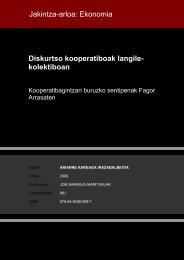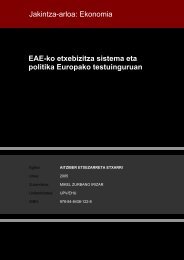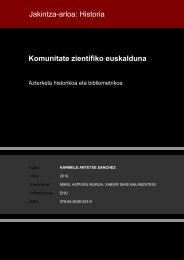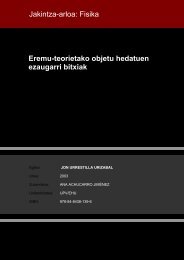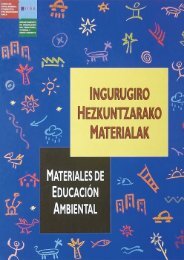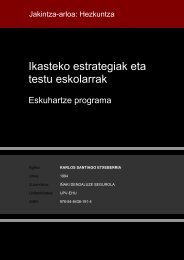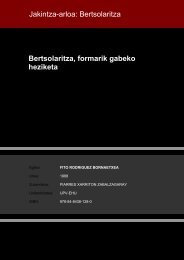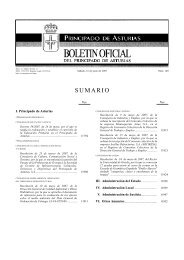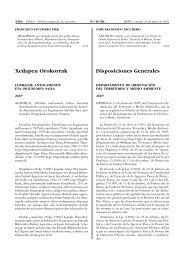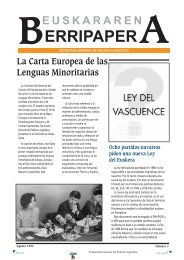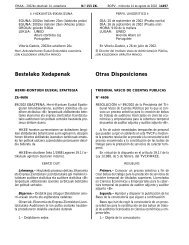MOLUSKUEN LISERI-GURUINEKO EPITELIOAREN ... - Euskara
MOLUSKUEN LISERI-GURUINEKO EPITELIOAREN ... - Euskara
MOLUSKUEN LISERI-GURUINEKO EPITELIOAREN ... - Euskara
You also want an ePaper? Increase the reach of your titles
YUMPU automatically turns print PDFs into web optimized ePapers that Google loves.
Emaitzak eta eztabaida<br />
Circatidal variation in epithelial cell proliferation in the mussel digestive<br />
gland and stomach<br />
Abstract: Epithelial cell renewal in mussel (Mytilus galloprovincialis, Lmk) digestive gland and stomach<br />
was investigated by bromodeoxyuridine (BrdU) immunohistochemistry. Mussels were exposed to 4 mg<br />
BrdU/l seawater continuously. Then, starting after 6 h treatment samples were collected every 2 h for 2 days<br />
and BrdU labelling was estimated by direct counting at the light microscope as ‰ BrdU positive cells. BrdU<br />
positive reaction was observed in the nuclei of digestive, basophilic, duct and stomach cells, as well as in<br />
hemocytes. Cell renewal in digestive diverticula is synchronised following a circatidal pattern: BrdU labelling<br />
increased during low tide and decreased during high tide. Clearcut mitotic figures were identified in<br />
digestive cells, which confirmed that mature cell types proliferate, in agreement with the results from<br />
immunohistochemistry for proliferating cell nuclear antigen (PCNA) immunohistochemistry. Epithelial cell<br />
renewal in the stomach also appeared to be synchronised.<br />
Key Words: bromodeoxyuridine, cell renewal, mitosis, tide, photoperiod, digestive gland, bivalves.<br />
Variación circamareal en la proliferación de células epiteliales en glándula<br />
digestiva y estómago de mejillón<br />
Resumen Se investigó la renovación de células epiteliales en glándula digestiva y estómago del<br />
mejillón (Mytilus galloprovincialis, Lmk) mediante inmunohistoquímica de bromodeoxiuridina (BrdU). Se<br />
expusieron contínuamente mejillones a 4 mg BrdU/l agua de mar. Así,transcurridas 6 h de haberse iniciado<br />
el tratamiento se recogieron muestras cada dos h durante 2 días y se estimó el marcaje de BrdU mediante<br />
recuento directo al microscopio fotónico en términos de ‰ de células BrdU positivas. Se observó reacción<br />
BrdU positiva en los núcleos de las células digestivas, basófilas, de los conductos y del estómago, así<br />
como en hemocitos. La renovación celular en los divertículos digestivos estaba sincronizada de acuerdo<br />
con un patrón circamareal: el marcaje con BrdU aumentaba durante la marea baja y disminuía durante la<br />
marea alta. Se identificaron cortes limpios de figuras mitóticas en células digestivas, lo que confirmó que<br />
las células maduras son capaces de proliferar, de acuerdo con resultados anteriores de<br />
inmunohistoquímica de PCNA (Proliferating Cell Nuclear Antigen). También la renovación de células del<br />
epitelio del estómago parecía estar sincronizada.<br />
Palabras clave: bromodeoxiuridina, renovación celular, mitosis, marea, fotoperiodo, glándula digestiva,<br />
bivalvos.<br />
104



